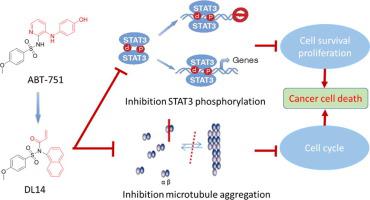Bioorganic Chemistry ( IF 4.5 ) Pub Date : 2022-05-10 , DOI: 10.1016/j.bioorg.2022.105864 Xuebao Wang 1 , Ying Lu 2 , Doudou Sun 2 , Jinheng Qian 2 , Sijun Tu 2 , Weixia Yue 2 , Humin Lin 2 , Haijie Tang 2 , Fanxi Meng 2 , Qin He 3 , Zixin Xie 2 , Yuan Zhang 2 , Huijun Chen 4 , Shumei Ma 5 , Zhigui Zuo 6 , Faqing Ye 7

|
Overexpressed tubulin and continuously activated STAT3 play important roles in the development of many cancers and are potential therapeutic targets. A series of 4-methoxy-N -(1-naphthalene) benzenesulfonamide derivatives were designed and optimized based on β-tubulin inhibitor ABT-751 to verify whether STAT3 and tubulin dual target inhibitors have better antitumor effects. Compound DL14 showed strong inhibitory activity against A549, MDA-MB-231 and HCT-116 cells in vitro with IC50 values of 1.35 μM, 2.85 μM and 3.04 μM, respectively. Further experiments showed that DL14 not only competitively bound to colchicine binding site to inhibit tubulin polymerization with IC50 values 0.83 μM, but also directly bound to STAT3 protein to inhibit STAT3 phosphorylation with IC50 value of 6.84 μM. Three other compounds (TG03, DL15, and DL16) also inhibit this phosphorylation. In terms of single target inhibition, DL14 is slightly inferior to positive drugs, but it shows a good anti-tumor effect in vivo, and can inhibit >80% of xenograft tumor growth. This study describes a novel 4-methoxy-N-(1-naphthyl) benzenesulfonamide skeleton as an effective double-targeted anticancer agent targeting STAT3 and tubulin.
中文翻译:

基于 ABT-751 发现 4-甲氧基-N-(1-萘基)苯磺酰胺衍生物作为微管蛋白和信号转导子和转录激活子 3 (STAT3) 的小分子双靶点抑制剂
过度表达的微管蛋白和持续激活的 STAT3 在许多癌症的发展中发挥着重要作用,是潜在的治疗靶点。基于β-微管蛋白抑制剂ABT-751设计并优化了一系列4-甲氧基-N-(1-萘)苯磺酰胺衍生物,以验证STAT3和微管蛋白双靶点抑制剂是否具有更好的抗肿瘤效果。化合物DL14在体外对A549、MDA-MB-231和HCT-116细胞表现出较强的抑制活性,IC 50值分别为1.35 μM、2.85 μM和3.04 μM。进一步实验表明,DL14不仅竞争性地结合秋水仙碱结合位点抑制微管蛋白聚合,IC 50值为0.83 μM,而且直接与STAT3蛋白结合抑制STAT3磷酸化,IC 50值为6.84 μM。其他三种化合物(TG03、DL15 和 DL16)也抑制这种磷酸化。在单靶点抑制方面,DL14略逊于阳性药物,但在体内表现出良好的抗肿瘤作用,可抑制>80%的异种移植肿瘤生长。这项研究描述了一种新型的 4-甲氧基-N-(1-萘基) 苯磺酰胺骨架,作为一种有效的针对 STAT3 和微管蛋白的双靶点抗癌剂。































 京公网安备 11010802027423号
京公网安备 11010802027423号